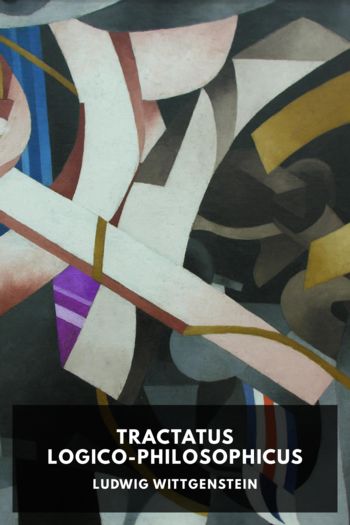Tractatus Logico-Philosophicus - Ludwig Wittgenstein (top 10 ebook reader TXT) 📗

- Author: Ludwig Wittgenstein
Book online «Tractatus Logico-Philosophicus - Ludwig Wittgenstein (top 10 ebook reader TXT) 📗». Author Ludwig Wittgenstein
The truth of tautology is certain, of propositions possible, of contradiction impossible.
(Certain, possible, impossible: here we have an indication of that gradation which we need in the theory of probability.)
4.465The logical product of a tautology and a proposition says the same as the proposition. Therefore that product is identical with the proposition. For the essence of the symbol cannot be altered without altering its sense.
4.466To a definite logical combination of signs corresponds a definite logical combination of their meanings; every arbitrary combination only corresponds to the unconnected signs.
That is, propositions which are true for every state of affairs cannot be combinations of signs at all, for otherwise there could only correspond to them definite combinations of objects.
(And to no logical combination corresponds no combination of the objects.)
Tautology and contradiction are the limiting cases of the combination of symbols, namely their dissolution.
4.4661Of course the signs are also combined with one another in the tautology and contradiction, i.e. they stand in relations to one another, but these relations are meaningless, unessential to the symbol.
4.5Now it appears to be possible to give the most general form of proposition; i.e. to give a description of the propositions of some one sign language, so that every possible sense can be expressed by a symbol, which falls under the description, and so that every symbol which falls under the description can express a sense, if the meanings of the names are chosen accordingly.
It is clear that in the description of the most general form of proposition only what is essential to it may be described—otherwise it would not be the most general form.
That there is a general form is proved by the fact that there cannot be a proposition whose form could not have been foreseen (i.e. constructed). The general form of proposition is: Such and such is the case.
4.51Suppose all elementary propositions were given me: then we can simply ask: what propositions I can build out of them. And these are all propositions and so are they limited.
4.52The propositions are everything which follows from the totality of all elementary propositions (of course also from the fact that it is the totality of them all). (So, in some sense, one could say, that all propositions are generalizations of the elementary propositions.)
4.53The general proposition form is a variable.
5Propositions are truth-functions of elementary propositions.
(An elementary proposition is a truth-function of itself.)
5.01The elementary propositions are the truth-arguments of propositions.
5.02It is natural to confuse the arguments of functions with the indices of names. For I recognize the meaning of the sign containing it from the argument just as much as from the index.
In Russell’s “+c”, for example, “c” is an index which indicates that the whole sign is the addition sign for cardinal numbers. But this way of symbolizing depends on arbitrary agreement, and one could choose a simple sign instead of “+c”: but in “~p” “p” is not an index but an argument; the sense of “~p” cannot be understood, unless the sense of “p” has previously been understood. (In the name Julius Caesar, Julius is an index. The index is always part of a description of the object to whose name we attach it, e.g. The Caesar of the Julian gens.)
The confusion of argument and index is, if I am not mistaken, at the root of Frege’s theory of the meaning of propositions and functions. For Frege the propositions of logic were names and their arguments the indices of these names.
5.1The truth-functions can be ordered in series.
That is the foundation of the theory of probability.
5.101The truth-functions of every number of elementary propositions can be written in a schema of the following kind:
( T T T T ) ( p , q ) Tautology in words: If p then p; and if q then q. (p⊃p.q⊃q) ( F T T T ) ( p , q ) Not both p and q. (~(p.q)) ( T F T T ) ( p , q ) If q then p. (q⊃p) ( T T F T ) ( p , q ) If p then q. (p⊃q) ( T T T F ) ( p , q ) If p or q. (p∨q) ( F F T T ) ( p , q ) Not q. (~q) ( F T F T ) ( p , q ) Not p. (~p) ( F T T F ) ( p , q ) p or q, but not both. (p.~q:∨:q.~p) ( T F F T ) ( p , q ) If p, then q; and if q, then p. (p≡q) ( T F T F ) ( p , q ) p ( T T F F ) ( p , q ) q ( F F F T ) ( p , q ) Neither p nor q. (~p.~q or p|q) ( F F T F ) ( p , q ) p and not q. (p.~q) ( F T F F ) ( p , q ) q and not p. (q.~p) ( F F F F ) ( p , q ) Contradiction (p and not p; and q and not q.) (p.~p.q.~q)Those truth-possibilities of its truth-arguments, which verify the proposition, I shall call its truth-grounds.
5.11If the truth-grounds which are common to a number of propositions are all also truth-grounds of some one proposition, we say that the truth of this proposition follows from the truth of those propositions.
5.12In particular the truth of a proposition p follows from that of a proposition q, if all the truth-grounds of the second are





Comments (0)